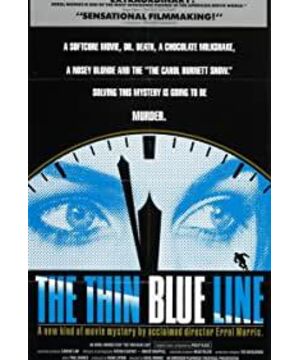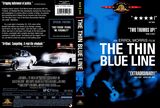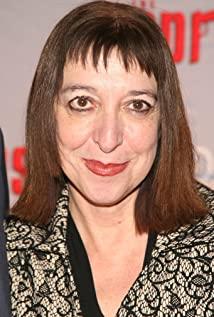(xixixi from the TV Documentary Research Class) If you just read the title of the film, you can't imagine what the documentary is about. The documentary has a clear narrative. The original film was told by Adams and Harrison about the incident in prison. With the recollection of the two people, the director used various film and television techniques to restore the shooting incident more than ten years ago. Then, the content of the film revolves around the so-called confession of the doubtful Adams and tells the bizarre trial, with three different crime scenes listed according to different witnesses. In the end, Harrison confessed in the interview, admitting that he was the real murderer at the end. Although initially told in the form of character recollections, the entire homicide and its investigation follow a chronological order. While watching, I felt that the subject of this documentary was not very certain, and felt that different audiences could find different themes, such as the fragility of justice. This is a living American judicial black satire. If the director hadn't rediscovered the case that had been on hold for more than ten years, Adams in the film would only face despair and death. Secondly, in this film, we can receive different information through the director's interviews with different characters, and see the primacy of personal interests and the dark side of human nature. Finally, when we see the deformed shape of American law, the horribly arbitrary side of the judiciary, when we come into contact with the frailties of human nature, justice does not seem to exist. The question of authenticity of historical documentaries has been a point of contention throughout. I searched for relevant information and found that Vertov put forward the theory of "movie eye" in 1922, and then, in the United States in the early 1960s, a group of documentarians led by Drew and Licock proposed The camera is always a bystander, no interviews are required, no reenactment, no lighting, no commentary, and all subjective interventions that may cause damage to the original ecology of life are excluded. In France, the real films represented by Jean Rouche, the Drew Group, and the Messos brothers also emphasized the need to shoot real life directly and reject fiction. Contrary to the above point of view, the documentary filmmaker Morris completely rejected these traditional documentary concepts, In his view, it is difficult for real movies to capture the actions that are taking place in front of them. What's more, there is no absolute objectivity in the world. Documentaries of any period and genre are subjective. After all, in terms of topic selection, shooting, and editing, producers cannot avoid taking personal factors. In this film, the director did not blindly pursue the so-called truth, but indirectly and roundly approached the truth through interviews with people related to the case. Respondents recalled details of the events they experienced in front of the camera, revealing different personality traits. These interviews not only advance the story, but also provide a survey and scrutiny of the anatomy at the social level. I have to say that I was still terrified when I watched this at night. The slightly weird music in the film created a confusing effect for the storytelling, and this music has the function of auxiliary editing, which enhances the sense of rhythm. In the director Morris's own words: From the perspective of each film, the music he uses is closely related to the narrative function, because music is also another way to lead the audience from the external real world into some kind of fantasy world. One detail that impressed me particularly about the whole film was the tape recorder at the end of the film, which recorded Harrison's confession. When we listen to Harrison's words and look at the compact tape recorder, we will have a strong sense of division in our minds, and we will find that this cold machine suddenly comes to life. The case was settled like this, and at the same time, I felt that Adams was too miserable. After so many years of unjust imprisonment, I was directly angry in it. In general, the director's exploration of the true nature of the documentary has achieved a rebellion and criticism of the direct film, and has also changed the traditional concept of the relationship between the documentary and reality, highlighting the unique characteristics of the new documentary film under the postmodernist trend of thought. Aesthetic features, a documentary of great value Indirect and roundabout approaching the truth. Respondents recalled details of the events they experienced in front of the camera, revealing different personality traits. These interviews not only advance the story, but also provide a survey and scrutiny of the anatomy at the social level. I have to say that I was still terrified when I watched this at night. The slightly weird music in the film created a confusing effect for the storytelling, and this music has the function of auxiliary editing, which enhances the sense of rhythm. In the director Morris's own words: From the perspective of each film, the music he uses is closely related to the narrative function, because music is also another way to lead the audience from the external real world into some kind of fantasy world. One detail that impressed me particularly about the whole film was the tape recorder at the end of the film, which recorded Harrison's confession. When we listen to Harrison's words and look at the compact tape recorder, we will have a strong sense of division in our minds, and we will find that this cold machine suddenly comes to life. The case was settled like this, and at the same time, I felt that Adams was too miserable. After so many years of unjust imprisonment, I was directly angry in it. In general, the director's exploration of the true nature of the documentary has achieved a rebellion and criticism of the direct film, and has also changed the traditional concept of the relationship between the documentary and reality, highlighting the unique characteristics of the new documentary film under the postmodernist trend of thought. Aesthetic features, a documentary of great value Indirect and roundabout approaching the truth. Respondents recalled details of the events they experienced in front of the camera, revealing different personality traits. These interviews not only advance the story, but also provide a survey and scrutiny of the anatomy at the social level. I have to say that I was still terrified when I watched this at night. The slightly weird music in the film created a confusing effect for the storytelling, and this music has the function of auxiliary editing, which enhances the sense of rhythm. In the director Morris's own words: From the perspective of each film, the music he uses is closely related to the narrative function, because music is also another way to lead the audience from the external real world into some kind of fantasy world. One detail that impressed me particularly about the whole film was the tape recorder at the end of the film, which recorded Harrison's confession. When we listen to Harrison's words and look at the compact tape recorder, we will have a strong sense of division in our minds, and we will find that this cold machine suddenly comes to life. The case was settled like this, and at the same time, I felt that Adams was too miserable. After so many years of unjust imprisonment, I was directly angry in it. In general, the director's exploration of the true nature of the documentary has achieved a rebellion and criticism of the direct film, and has also changed the traditional concept of the relationship between the documentary and reality, highlighting the unique characteristics of the new documentary film under the postmodernist trend of thought. Aesthetic features, a documentary of great value The tape recorder recorded Harrison's confession. When we listen to Harrison's words and look at the compact tape recorder, we will have a strong sense of division in our minds, and we will find that this cold machine suddenly comes to life. The case was settled like this, and at the same time, I felt that Adams was too miserable. After so many years of unjust imprisonment, I was directly angry in it. In general, the director's exploration of the true nature of the documentary has achieved a rebellion and criticism of the direct film, and has also changed the traditional concept of the relationship between the documentary and reality, highlighting the unique characteristics of the new documentary film under the postmodernist trend of thought. Aesthetic features, a documentary of great value The tape recorder recorded Harrison's confession. When we listen to Harrison's words and look at the compact tape recorder, we will have a strong sense of division in our minds, and we will find that this cold machine suddenly comes to life. The case was settled like this, and at the same time, I felt that Adams was too miserable. After so many years of unjust imprisonment, I was directly angry in it. In general, the director's exploration of the true nature of the documentary has achieved a rebellion and criticism of the direct film, and has also changed the traditional concept of the relationship between the documentary and reality, highlighting the unique characteristics of the new documentary film under the postmodernist trend of thought. Aesthetic features, a documentary of great value
View more about The Thin Blue Line reviews









